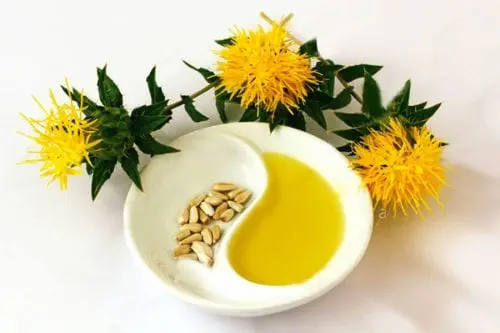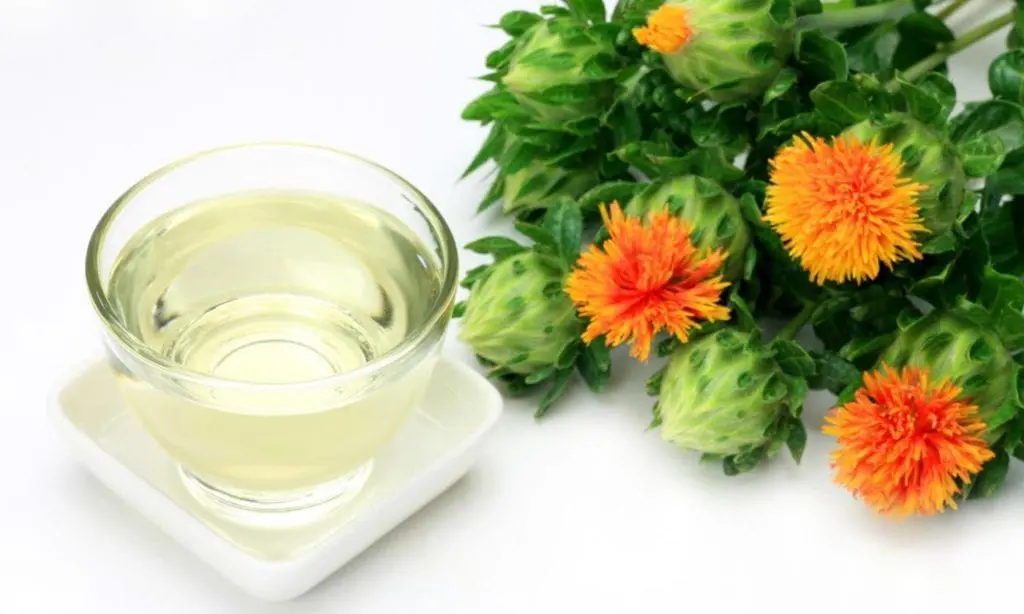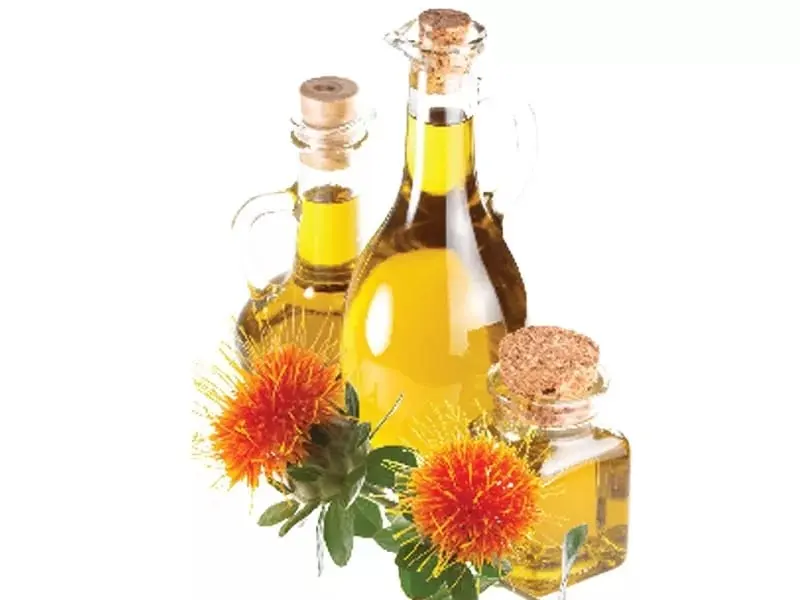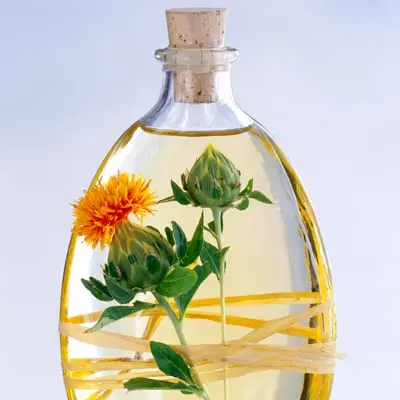Contents
- DESCREPTION
- WHAT TO PAY ATTENTION TO WHEN BUYING SAFFLOR OIL
- NAME AND LABELS
- PLANT, SAFFLOR OIL TYPES AND REGIONS OF PRODUCTION
- FALSIFICATION OF OIL
- METHOD OF OBTAINING
- COMPOSITION
- TEXTURE, COLOR AND FRAGRANCE
- SAFFLOWER OIL BEHAVIOR ON THE SKIN
- MEDICAL PROPERTIES
- COSMETOLOGICAL PROPERTIES OF SAFFLOWER OIL
- SAFFLOWER OIL USE IN COOKING
- FEATURES OF APPLICATION
DESCREPTION
Safflower oil, belonging to the bases with absolute dominance in the composition of one of the fatty acids, is one of the most active plant components for a complex softening effect and improving the condition of dry skin and hair. Safflower oil is actively used in cooking, cosmetology, and even in the production of construction products.
Safflower oil, studied relatively recently, acquired its industrial significance only in the middle of the last century. It is actively used in the production of linoleum, as a non-yellowing, color-retaining base for paints, drying oils, varnishes and in soap making.
Nevertheless, the main role of safflower oil is its active culinary use and cosmetological characteristics that allow it to be used as a base vegetable oil.
In cosmetology and aromatherapy, safflower oil is considered one of the best for eliminating vascular pattern, softening, moisturizing the skin, while the talents of the oil are used mainly in working with dry and problem skin.
WHAT TO PAY ATTENTION TO WHEN BUYING SAFFLOR OIL
It is an affordable, reasonably priced oil that can be compared to extra virgin olive oil. High quality safflower oil, suitable for cosmetic purposes, is best bought in special aromatherapy departments, in other highly specialized sources.
This oil is also found on supermarket shelves, in pharmacies and culinary departments, but the products presented there are most often stabilized, refined oil, the properties of which have been largely lost.
Due to its instability and extremely short shelf life, cold-pressed safflower oil, which is the only type of oil suitable for aromatherapy purposes, is almost never marketed on a large scale, and only responsible aromatherapy manufacturers distribute it in full compliance with technology.
NAME AND LABELS
It is quite simple to understand the markings of safflower oil: in order to make sure that it is the safflower oil that came into your hands, it is enough to check the Latin names, which must be indicated on quality products.
Safflower oil can only be labeled carthamus tinctorius, or “safflower oil”.
PLANT, SAFFLOR OIL TYPES AND REGIONS OF PRODUCTION

Since safflower oil is classified according to the type of raw material used and belongs to rather narrow production cycles, manufacturers always specify the sources of the oil and the part of the plant used to obtain it in the instructions for high-quality oil.
Safflower oil is extracted from both dyeing safflower and its species, but it is preferable to choose oils from the base plant, which is a fairly tall annual with beautiful and bright fiery inflorescence baskets.
Safflower oil is divided into two main types:
- culinary oil derived from refined seeds, which can be used as a base oil without special precautions and used in cooking;
- obtained from unrefined seeds – bitter, toxic, called technical, which is used only for industrial purposes, for example, in paint and varnish production.
When buying oil, be sure to pay attention to whether the manufacturer has indicated the type of oil and raw materials used and whether it can be ingested and used on the skin.
In nature, safflower is most widespread in the Mediterranean and countries of production from this region are considered preferred, regarded as sources of the highest quality safflower oil. In addition to Spain and Portugal, and more rare oils from Italy and France, high quality safflower oil is now also supplied by Australia.
Safflower is also grown for industrial purposes in Central Asia, Brazil, China, the USA, Turkey, but the quality of the oil is usually inferior to the Australian and European counterparts.
FALSIFICATION OF OIL
In the classical sense, counterfeiting of safflower oil, the production of which is usually combined with the growing area, is rare. All counterfeits are oils that can be replaced with diluted or canned bases.
Most often, cold-pressed safflower oil is substituted for stabilized, refined oil. It is very easy to distinguish fakes of this type by studying the expiration date: when selling refined oil, it is usually more than one year, and the highest quality oil should be from 3 months to six months.

Also, cold-pressed safflower oil can be replaced with a mixture with other neutral bases with the addition of preservatives.
The most dangerous thing for extremely unstable oil is violation of storage conditions, as a result of which even the highest quality oil goes rancid even in warehouses and counters. Such products can only be recognized after purchasing and opening the bottle. The oil is not recommended for any purpose at the first sign of a strong or rancid odor.
In order to avoid buying low-quality products, it is important to check whether the manufacturer has provided all the necessary information, to make sure that the oil is fresh in terms of shelf life.
METHOD OF OBTAINING
Safflower oil is obtained by a fairly simple method of cold pressing by pressing sufficiently small seeds in ribbed white achene wrappers. Technical oil is obtained without cleaning seeds, culinary and cosmetic oil – with the obligatory complete cleaning of seeds from the wrappers.
Oil production is quite productive, as the seeds contain on average about 40% of the base oil. After pressing, the safflower oil is filtered, depending on the purpose and form of release, it is preserved with the addition of vitamin E or refined, separating unwanted and aggressive impurities.
COMPOSITION

The composition of safflower oil is dominated by linoleic acid, accounting for about 80% of the total mass, while it is presented in a fairly rare conjugated form.
The effect of safflower oil on the skin is also determined by the high content of vitamin K, which is responsible for the restoration of blood vessels.
In addition to linoleic, the fatty acid composition of the oil includes oleic and palmitic acids with admixtures of arachidic, stearic, myristic and linolenic acids, which are responsible for the active assimilation of vitamin E and the activity of serotonin derivatives.
Since the oil does not contain squalene, it is better to combine it with other bases with its high content to enhance its regenerating properties.
TEXTURE, COLOR AND FRAGRANCE
One of the main advantages of safflower oil, which determines the almost unlimited possibilities of its use in cooking, is the neutrality of taste and smell.
Oil from peeled seeds, in contrast to the technical form, is practically colorless, with only a slight, subtle shade of orange color.
Only when applied to the skin or slightly heated does safflower oil show subtle nuances of a hay-like scent with slight oily-rancid trails, but usually the scent is almost indistinguishable.
As for the taste, safflower oil is not noticeable when added to oil mixtures, it does not saturate both cold and hot dishes with aroma and flavor nuances, and is perceived as not very viscous and pleasant. When pure oil is consumed, light herbal, subtle aftertaste nuances may appear.
SAFFLOWER OIL BEHAVIOR ON THE SKIN
This is a fairly light and fluid oil that spreads evenly over the surface of the skin with an almost imperceptibly pronounced viscosity. On any skin type, the safflower base is quickly and productively absorbed without leaving a feeling of oily or film, even when applied in large quantities.
When applied to the skin, safflower oil has an immediate emollient effect. This effect is most pronounced on dry skin and hair.
MEDICAL PROPERTIES

The healing properties of safflower oil are manifested mainly when used internally. Specific consumption or use as a complete alternative to sunflower oil can improve appetite and reduce blood cholesterol levels.
Its effect is mainly directed at low density lipoproteins, at normalizing and stabilizing cholesterol levels and preventing atherosclerosis.
Safflower oil is a source of linoleic acid, which is necessary for normalization of metabolism and productive metabolism, and as a source of vitamin E it is considered one of the most biologically active cooking oils with a wide application profile.
Vitamin K content allows safflower oil to play the role of an additive aimed at strengthening blood vessels, preventing atherosclerosis and cardiovascular diseases.
This is one of the best oils for weight loss: the presence of the conjugated form of linoleic acid (CLA) promotes the active breakdown of fatty deposits, reducing body volume due to the productive decomposition of the subcutaneous fat layer.
When taken orally, safflower oil also demonstrates a gentle laxative effect.
COSMETOLOGICAL PROPERTIES OF SAFFLOWER OIL
The main characteristic of safflower oil is its high emollient properties, but it would be a big mistake to limit the effect of oil on the state of the epidermis only by them. Safflower oil exhibits powerful antioxidant and revitalizing properties for visible improvements in well-being and aesthetics from the first application.
Demonstrates this oil and healing ability.
Due to the dominance of linoleic acid, this oil is one of the main ones for working with very dry and sensitive dry skin. The action of safflower oil is aimed at softening the skin and normalizing lipid functions.

The moisturizing effect of the safflower seed oil is very specific: it is not a classic base for saturating the epidermis with moisture, but it has two irreplaceable talents – moisture retention and moisture regulation.
Not promoting active and deep hydration, safflower oil, due to the saturation of cells with active components, increases the skin’s ability to retain moisture inside, helping to normalize the hydrolipid balance.
This is one of the best bases for eliminating vascular and capillary patterns, rosacea and normalizing skin color, the effect of which in this area is not directed at an instant effect, but at a systemic improvement in the condition of capillaries and blood vessels, due to which the very source of the problem is eliminated.
Safflower oil is great for dealing with uncontrolled skin redness.
Like any oil that prevents excessive dryness and moisture loss, safflower is also effective as a sunscreen, but due to the presence of polyunsaturated acids, it can leave an unpleasant rancid mark when sunbathing due to accelerated oxidation.
Safflower oil is an excellent restorative base for the care of thin, damaged, dry hair, allowing not only to renew the structure and restore strength, but also restore shine and beauty to the hair.
SAFFLOWER OIL USE IN COOKING
As a vegetable oil actively used in cooking, safflower oil is in no way inferior to sunflower oil both in characteristics and in taste, but surpasses the latter in biological activity and a healing effect on the body.
Safflower oil is considered one of the most resistant to high temperatures oils with a high smoke threshold, so it can be used not only in the preparation of dressings, sauces, salads, in cold dishes and snacks, but also in the preparation of main dishes, including frying or baking.
FEATURES OF APPLICATION

Safflower oil, with the exception of cases of individual intolerance, has no contraindications and precautions. The rapid oxidation and tendency to rancidity of the oil should be taken into account when using the base during sunbathing, when using the oil that has been open for a long time.
Safflower oil can leave a rancid mark on clothing and fabrics.
High-quality cold-pressed oil is stored for 3 to 6 months, subject to dark containers and complete tightness, when placed in the refrigerator immediately after opening. It is forbidden to use safflower oil after the expiration date or if the manufacturer’s recommendations are not followed.
Techniques and dosages for safflower oil:
in sunscreens as an emollient and restorative, moisture-retaining component in the form of no more than 20% additive to a basic agent or oil;
in products for systemic, therapeutic care for dry hair in pure form in mixtures, as an additive to shampoos and balms (1 tablespoon per 100 ml):
- in night creams for dry and sensitive skin as a base or cream substitute in its pure form;
- to improve cosmetics in the amount of 10-20% additive;
- in its pure form to combat rosacea using the application method;
- in pure form or in the amount of a 25% additive in anti-aging cosmetics;
- in culinary experiments in combination with other vegetable oils or in pure form;
- as a basis for massage mixtures for dry skin.









